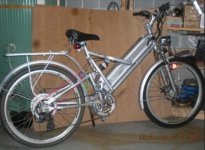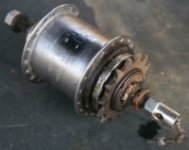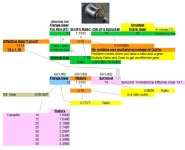markz
100 TW
How does one calculate using two normal IGH with a gear mounted on the spoke flange for both IGH?
Crank of 10T going to the regular #1 IGH Gear of 20T
3 Speed IGH internal ratio's are both 75/100/125%
A 30T flange mounted gear going to the normal #2 IGH Gear of 40T with same ratios, and a 50T flange gear.
Going to a 60T cassette on the back 26" wheel.
Both set to 75%
What I do not understand is the crank gear of 10T is going to 1st IGH, with its "normal" operating gear of 20T and the IGH set to 75%, but then there is an added gear mounted on the flange. Different then the common Compound Gearing thats easily solvable.
How does one finish the calculation?
--------
Simpler gearing situations.
With just one IGH
(Out/In)*IGH % Ratio
IGH Gear of 20 / Crank Gear of 10
= 20/10 is 2
multiply
IGH % of 75% = 1.50 on a 26" wheel.
IGH internals 75/100/125%
IGH % of 125% = 20/10=2*1.25(125%) is 2.50
1.50 vs 2.50
IGH at 75% is a 2.50 which is more torque and less speed for same cadence
75% is a 1.50; more speed and less torque for same cadence.
Normal Bicycle
22T Crank and 44T Cassette 44T/22T = 2 for Hills
44T Crank and 10T Cassette 10T/44T = 0.23 for Speed
Crank of 10T going to the regular #1 IGH Gear of 20T
3 Speed IGH internal ratio's are both 75/100/125%
A 30T flange mounted gear going to the normal #2 IGH Gear of 40T with same ratios, and a 50T flange gear.
Going to a 60T cassette on the back 26" wheel.
Both set to 75%
What I do not understand is the crank gear of 10T is going to 1st IGH, with its "normal" operating gear of 20T and the IGH set to 75%, but then there is an added gear mounted on the flange. Different then the common Compound Gearing thats easily solvable.
How does one finish the calculation?
--------
Simpler gearing situations.
With just one IGH
(Out/In)*IGH % Ratio
IGH Gear of 20 / Crank Gear of 10
= 20/10 is 2
multiply
IGH % of 75% = 1.50 on a 26" wheel.
IGH internals 75/100/125%
IGH % of 125% = 20/10=2*1.25(125%) is 2.50
1.50 vs 2.50
IGH at 75% is a 2.50 which is more torque and less speed for same cadence
75% is a 1.50; more speed and less torque for same cadence.
Normal Bicycle
22T Crank and 44T Cassette 44T/22T = 2 for Hills
44T Crank and 10T Cassette 10T/44T = 0.23 for Speed




